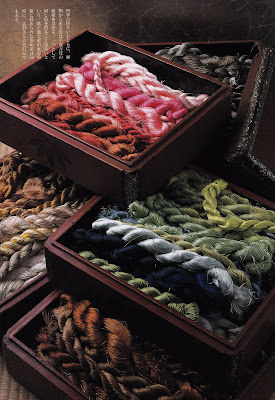The Japanese government, with the goal of preserving important intangible cultural assets supports a system of 'Living National Treasures'. There are 16 categories in the performing arts and crafts: Gagaku, Noh, Bunraku, Kabuki, Kumi Odori, Music, Dance, and Drama Crafts: Ceramics, Textiles, Lacquerware, Metalworking, Dollmaking, Woodworking, Papermaking, and Miscellaneous Crafts. I met a textile one! Several times... I am certain she hated me. First of all I didn't realize at the time what a big deal being a Living National Treasure is. She is a friend of a friend and I heard she wanted to meet me. ( Instead of feeling honored I thought, "What kind of rinky dink system is this living treasure stuff?" (Treating people like Gods gives me the shivers actually.) So I went and met her. I was completely in awe of her work and dedication. At the time I was passionaltely raising silkworms and breeding different ancient varities. ( I would get the eggs from the Ministry of Agriculture to do research.) It was all pretty much straightforward stuff. My life was submerged in silk and figured that the Living National Treasure must have knowledge that would make anything I had picked up look like instant noodles.
Silk threads dyed with natural dyes and a patchwork kimono from scraps of her weaving by Shimura Fukumi. The atmosphere of the gallery was deadly respectful and mysteriously religious. Then the dumb ox Canadian who can't speak honorific and humble Japanese naturally, walks in bursting with technical questions on silk de-gumming. I really wanted to know how she did it. I was taught to burn some rice straw and do it with the ash alkaline. There she was standing like an un-approchable angel (Sounds like a Rolling Stones song) and with that spirit and curiosity overflowing I barraged her with technical questions. (I thought she was being coy not answering them. ) Then she did something I can't forget. I don't know if there is an actual word for this action. You pump a lot of air into the space between your front teeth and upper lip making it balloon out and you scowl in frustration at the same time and quiver slightly. It was a Forrest Gump moment. I had put her on the spot asking questions she couldn't answer in front of her peers. Instead of slunking away I made matters worse by a lousy English, "I'm sorry." I met her again a year later in a less formal setting and she was friendly but a little uneasy. I got it right the second time. I tried to look harmless and kept my mouth shut. She is almost 90 now. And she is not only a Japanese National Treasure but a treasure for all us humans on this planet. Immensely talented as a writer, a kimono designer, a natural dyer, a weaver and a teacher. Shimura Fukumi. She writes and writes and weaves and weaves. And many around her write about her and weave from her inspiration. A well-documented and very approachable angel. I will be certain to share as much as I can with the tour members what I know about her work.
Bryan
Bryan





How lucky you are to know her...and us also, for you share her with us...
ReplyDeleteI like how you described her: You pump a lot of air into the space between your front teeth and upper lip making it balloon out and you scowl in frustration at the same time and quiver slightly. It was a Forrest Gump moment. I hope you can demonstrate the action for us later... or only living national treasure could do!
ReplyDeletegreat, great story!all the nuances of japanese social graces are very hard to understand at first.then when you become a real japanophile they all make sense!
ReplyDeletelove those shuttles.
Interesting, are you quite sure she was unable to answer your technical queries? It sounds so radically different an approach to the Japanese way of passing on knowledge that I am sure she was utterly taken aback. A friend of mine who was apprentice to a master carpenter swept the floor and watched for 6 weeks before being allowed to learn the most basic task by copying and he was already a master carpenter in Germany. Without first demonstrating his humility and subjugation to the master he would have learned nothing.
ReplyDeleteI was out of line asking her in those circumstances. (But she didn't know the difference between de-gumming oak-feeding silk cocoons and the regular mulberry ones.)
ReplyDeleteI studied tea ceremony for many years. I was fine with the humility part. I mean... how can you not be humbled by the tea ceremony? But I had trouble with subjugating myself to something somewhat cult like.
The demands made by the master craftsperson on potential apprentices certainly weeds out the field. I can see how the standards and attitude also make approaching traditional Japanese arts unattractive for youngsters.